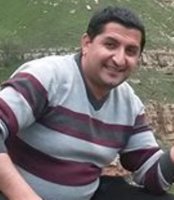Early 1990th brought dark clouds of heavy rains to Rustamova Sayyara’s life as well, as they did with more than 800 000 Internally Displaced People. In April 1993 the dark clouds brought severe "Daghlig Garabag” storm which destroyed the house, fruitful garden, cattle, joyful living of The Rustamovs’ in Kalbajar region and brougt the family to Nematabad village of Yevlakh region.
Assuredly, at least one person in the family had to be inspired to keep the family alive and struggling. And that very person was Sayyara Rustamova – the mother of the family, whose daughter is fully physically disabled.
For living the family used the limited resources that could find in nearby areas, and constructed the "asylum house” shown in Photo 1, and has been living there for 18 years. The main income mean of the Rustamovs is cattle-breeding.
Till involvement to the "Community Based Support to Producers of Dairy Products” project, Sayyara tried to meet her household’s and family’s daily needs via selling the milk from three cows, therefore she took the milk to the region centre in Yevlakh. That meant several times more extra expenses for Sayyara: a) about 1/4 of the income from milk were spent to transportation and ticket fee, b) half of her day were lost for the trip and the other half for waiting for clients, c) quite most portion of the product fermented or wasted in busses or because of inappropriate reservation. To add Sayyara’s limited sale skills and lack of proper client behavior and experience, expenses for a stand in market and other issues, it is not difficult to imagine the insignificance of the profit she gained beforehand.
In November 2009 Umid Support to Social Development Public Union launched "Community Based Support to Producers of Dairy Products”project under the financial support of USAID and BP and partners. Nematabad village of Yevlakh region, where Sayyara Rustamova and her family settled is one of the target communities of the project.
The support program building capacities has been applied in several steps: first the community awareness and community capacities were refreshed and developed, later the project staff developed target beneficiaries skills and knowledge on cattle-breeding, production of milk and dairy products, promotion of productivity and developing efficiency, and discussions were held about the strategies for sustainable production and business expansion. New information and training on the ways of increasing the volume and quality of dairy products, importance of Milk Collection Points (MCP) in communities, care and feeding the cattle, milk procurement, arrangement and management of veterinary services, milk yielding, storage and transportation developed the beneficiaries, including Sayyara’s appropriate capacities.
Due to the provided support the quality and volume of the milk and the producers’ income increased.
The constructed MCP avoided Sayyara from time and extra expenses loss, she regularly yields milk of three cows and sells the high quality and fresh milk to the MCP and is paid in time. Thus she began to gain 4-5 AZN daily, and started to improve their living. The daily income gave the family opportunity to make little repairs inside and to buy the necessary things for their household – she bought silk covers for the blankets and wool mattresses she made for her daughters (approximate cost 100 AZN), plates, bucket, kettle (70 AZN) and a dress-table (200 AZN), which was a real surprise for her daughters.
From the discussion with Sayyara:
"...we have three cows. Before the project I was not able to sell the milk in time, it fermented, or wasted, or I sold it to any cost the client offered, because very limited number of clients. The worst, client was not satisfied with the quality of the milk. Thanks to the project targeting our village as well, I developed my capacities on feeding the animals, yielding and storing milk. Using the knowledge, I managed to improve the quality of the milk. And after construction of MCP in the community I began to sell the milk there and get my in-cash money timely. In May 2011 ay sold 330 l milk and began to purchase necessary things for my household. I witnessed the accuracy of the working system of the MCP and understood the profitability of cattle-breeding, and I began thinking of improving my business. I began to apply the knowledge I got at training sessions, and via taking appropriate care I managed to increase the quality and volume of the milk. In June 2011 we managed to sell 708 liters milk, almost 95% improvement! And we bought the dress-table for my daughters.
Timely and attentive care to animals, keeping them clean and cozy and their timely feeding improved the quality and increased daily milk production from 16.5 liter to 26.5 l, correspondingly our daily income increased to 7-8 AZN. I am thinking to increase the number of cattle and get seriously engaged in cattle-breeding. I am heartedly thankful to USAID, Umid SSD PU and BP and Partners for this support and developed capacities”.
The Rustamovs are thinking to apply for agro-culture development credit, explained them during their meeting with credit institution representatives. With that credit they plan to buy two cows more and repay the rates with the money they’ll get from milk sales. This approach made the family more optimistic. The family now sees cattle-breeding as a business and is highly motivated to get seriously engaged in it.



